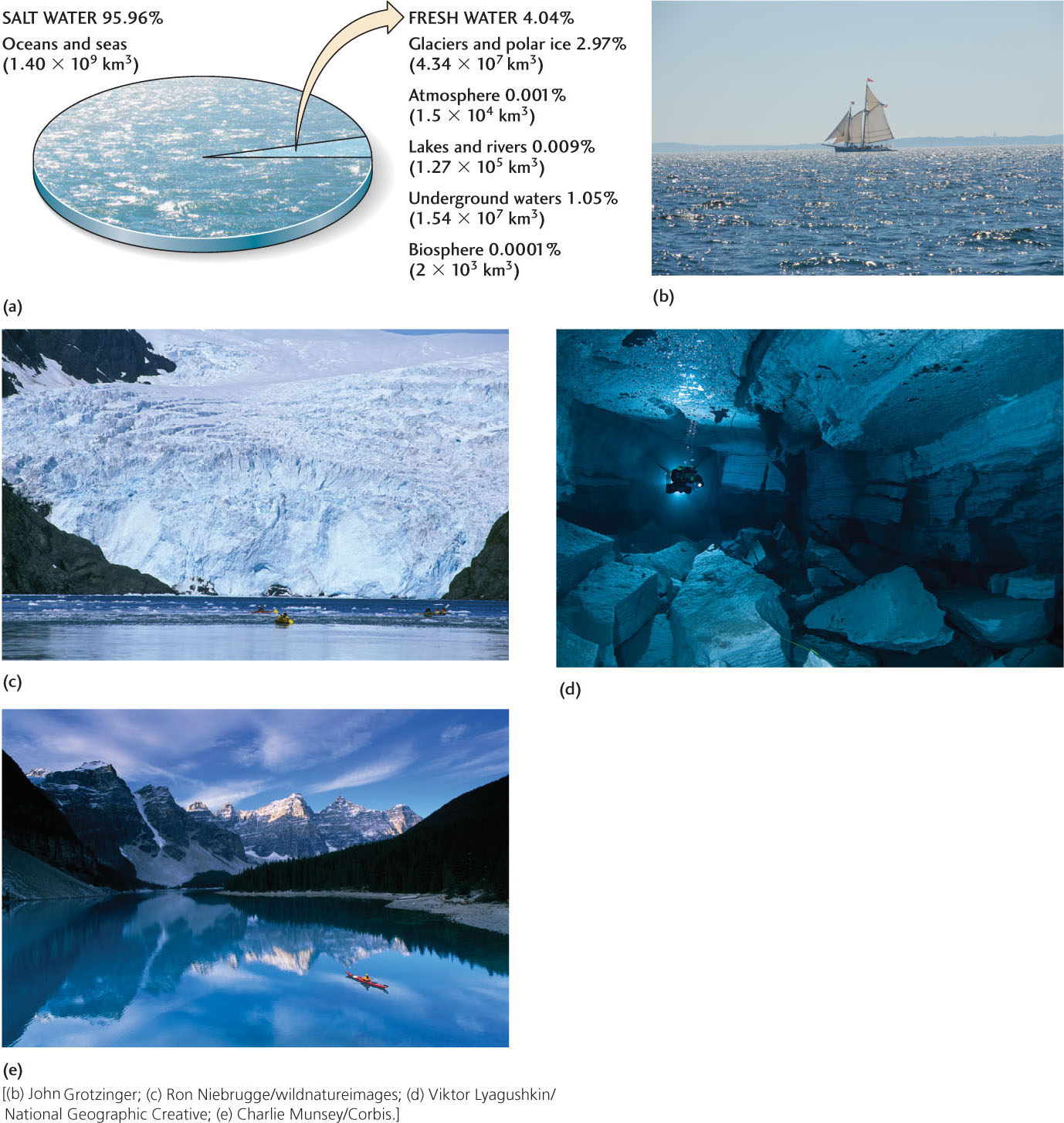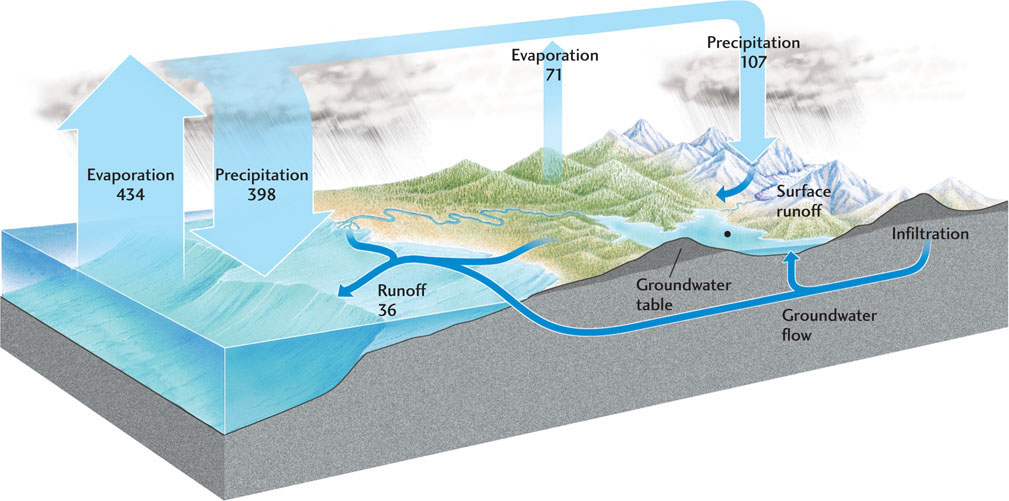The Geologic Cycling of Water
At what rates can we pump water from underground reservoirs without depleting them? What will be the effects of climate change on water supplies? Informed decision making about the conservation and management of water resources requires knowledge of how water moves on, over, and under Earth’s surface and how this flow responds to natural changes and human modifications. This field of study is known as hydrology.
Flow and Reservoirs
We can see water in Earth’s lakes, oceans, and polar ice caps, and we can see water moving over Earth’s surface in streams and glaciers. It is harder to see the massive amounts of water stored in the atmosphere and underground, or the flows of water into and out of these storage places. As water evaporates, it moves into the atmosphere as water vapor. As it falls from the sky as rain and sinks into the ground, it becomes groundwater—the mass of water that flows beneath Earth’s surface. Because organisms use water, small amounts of water are also stored in the biosphere.
Each place that stores water is referred to as a reservoir. Earth’s largest natural reservoirs, in the order of their size, are the oceans; glaciers and polar ice; groundwater; lakes and rivers; the atmosphere; and the biosphere. Figure 17.1 shows the distribution of water among these reservoirs. Although the total amount of water in rivers and lakes is very small compared with the amounts in the oceans and even in groundwater, these reservoirs of water are important to human populations because they do not contain salt or high concentrations of other dissolved materials.

Reservoirs gain water from inflows, such as rain and streams running in, and lose water from outflows, such as evaporation and streams running out. If inflow equals outflow, the size of the reservoir stays the same, even though water is constantly entering and leaving it. These flows mean that any given quantity of water spends a certain average time, called the residence time, in a reservoir.
How Much Water Is There?
Earth’s total water supply is enormous—about 1.4 billion cubic kilometers distributed among the various reservoirs. If all of that water covered the land area of the United States, it would submerge the 50 states under a layer of water about 145 km deep. This total is constant, even though the flows from one reservoir to another may vary from day to day, year to year, and century to century. Over these geologically short time intervals, there is neither a net gain nor a net loss of water to or from Earth’s interior, nor any significant loss from the atmosphere to outer space.
The Hydrologic Cycle
All water on Earth cycles among the various reservoirs in the oceans, atmosphere, and on and under the land surface. The cyclical movement of water—from the oceans to the atmosphere by evaporation, to Earth’s surface by precipitation, to streams through runoff over and under the ground, and back to the oceans—is called the hydrologic cycle (Figure 17.2).

Within the range of temperatures found at Earth’s surface, water shifts among the three states of matter: liquid (water), gas (water vapor), and solid (ice). These transformations power some of the main fluxes from one reservoir to another. Earth’s external heat engine, powered by the Sun, drives the hydrologic cycle, mainly by evaporating water from the oceans and transporting it as water vapor in the atmosphere.
Under the right temperature and humidity conditions, water vapor condenses into the tiny droplets of water that form clouds and eventually fall as rain or snow—together known as precipitation. Some of the precipitation that falls on land soaks into the ground by infiltration, a process by which water enters rock or soil through cracks or small pores between particles. Part of this groundwater evaporates through the soil surface and returns to the atmosphere as water vapor. Another part moves through the biosphere as it is absorbed by plant roots, carried up to the leaves, and returned to the atmosphere by a process called transpiration. Most of this groundwater, however, flows slowly underground. The residence time of water in groundwater reservoirs is long, but it eventually returns to the surface in springs that empty into rivers and lakes, and thus returns to the oceans.
The precipitation that does not infiltrate the ground runs off the land surface, gradually collecting into streams. The sum of all precipitation that flows over the land surface, including not only streams but also the fraction that temporarily infiltrates near-surface soil and rock and then flows back to the surface, is called runoff. Some runoff may later seep into the ground or evaporate from rivers and lakes, but most of it eventually flows into the oceans.
Snowfall may be converted into ice in glaciers, which return water to the oceans by melting and runoff, and to the atmosphere by sublimation, the transformation of water from a solid (ice) directly into a gas (water vapor).
Most of the water that evaporates from the oceans returns to them as precipitation. The remainder falls over land and either evaporates or returns to the oceans as runoff. Figure 17.2 shows how the total flows among reservoirs balance one another in the hydrologic cycle. The land surface, for example, gains water from precipitation and loses the same amount of water by evaporation and runoff. The oceans gain water from runoff and precipitation and lose the same amount by evaporation. More water evaporates from the oceans than falls on them as precipitation. This loss is balanced by the water returned as runoff from the continents. Thus, on a global scale, the size of each reservoir stays constant. Variations in climate, however, produce local variations in the balance among evaporation, precipitation, runoff, and infiltration.
471
How Much Water Can We Use?
Only a very small proportion of Earth’s enormous supply of water is useful to human society. The global hydrologic cycle ultimately controls our water supplies. For example, the 96 percent of Earth’s water that resides in the oceans is essentially off limits to us. Almost all the water we use is fresh water—water that is not salty. Artificial desalination (the removal of salt) is now producing small but steadily growing amounts of fresh water from seawater in areas such as the arid Middle East. In the natural world, however, fresh water is supplied only by rain, rivers, lakes, groundwater, and water melted from snow or ice on land. All these waters are ultimately supplied by precipitation. Therefore, the practical limit to the amount of natural fresh water that we can ever envision using is the amount steadily supplied to the continents by precipitation.
472